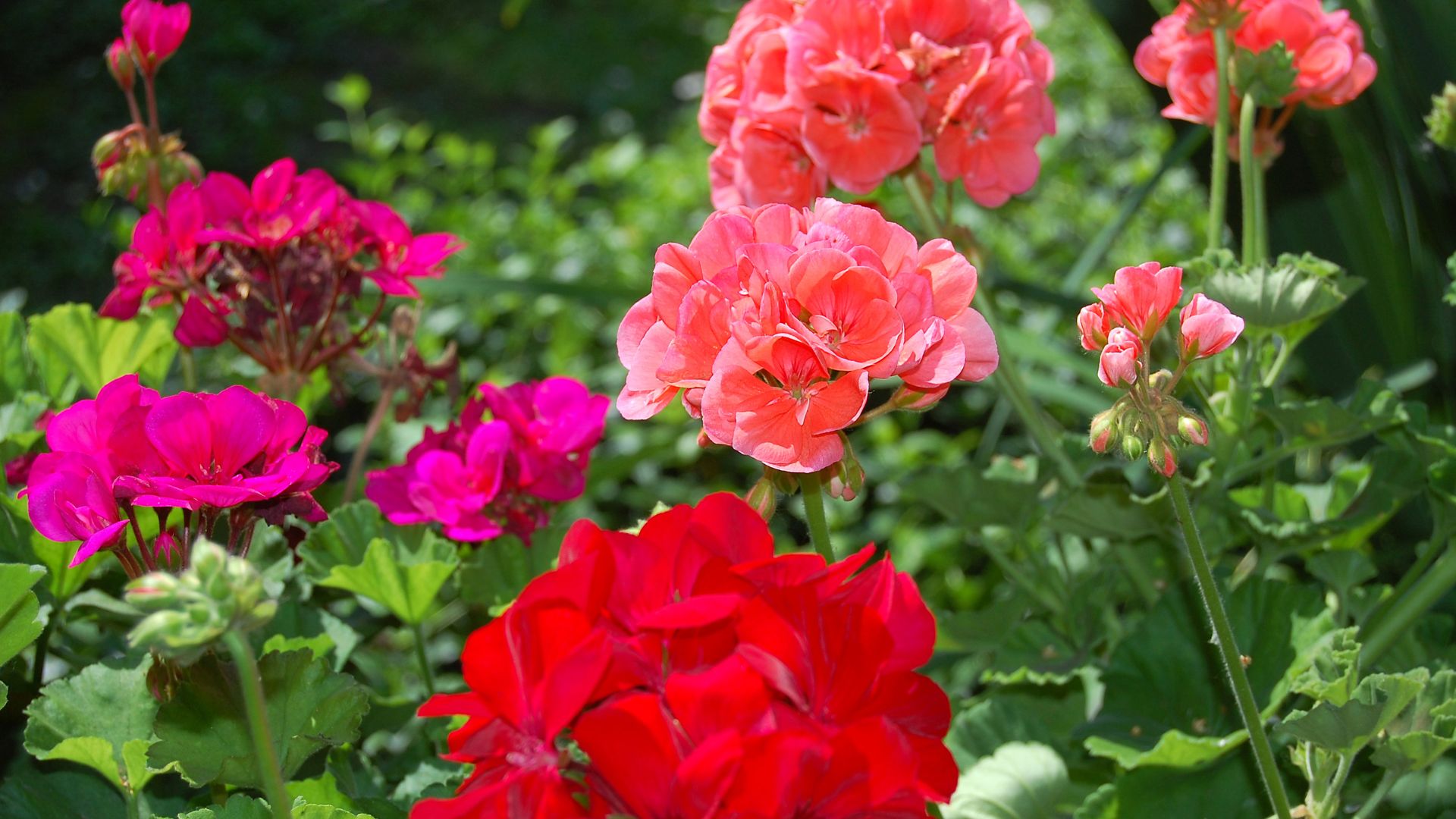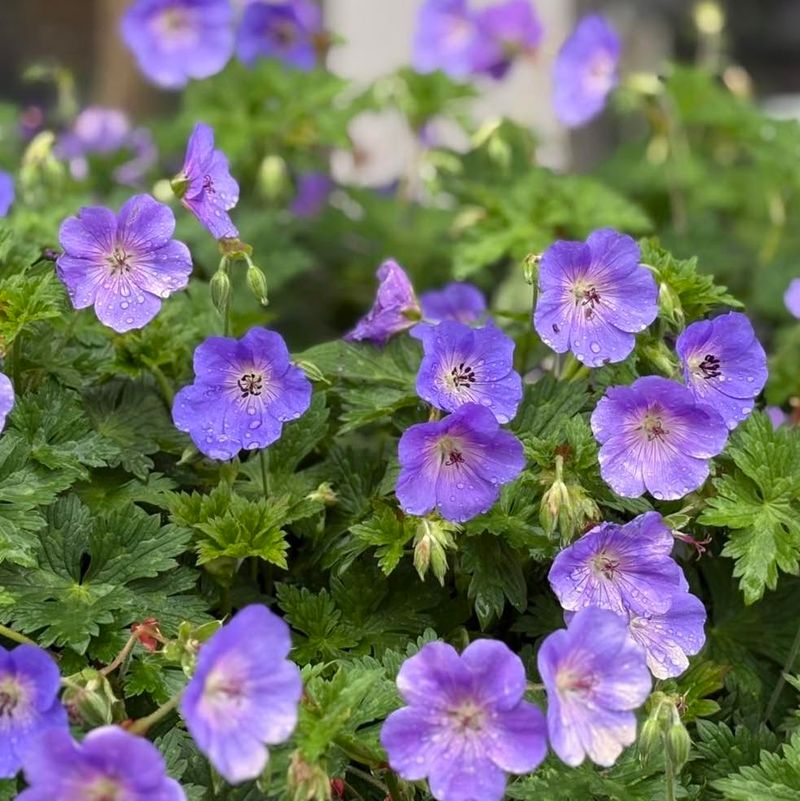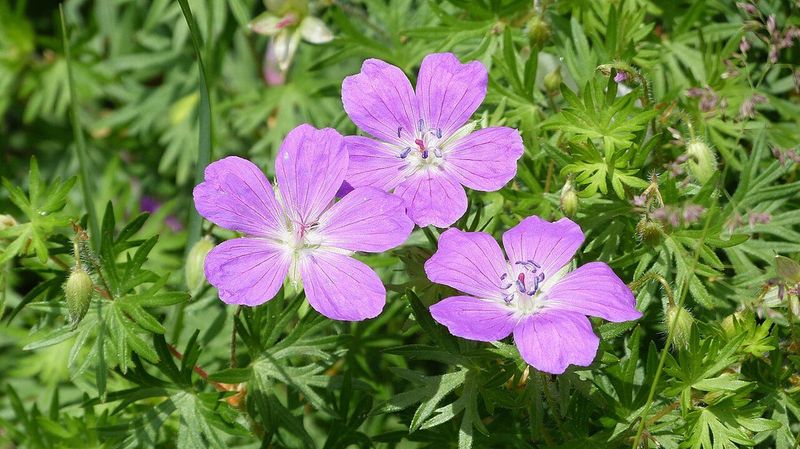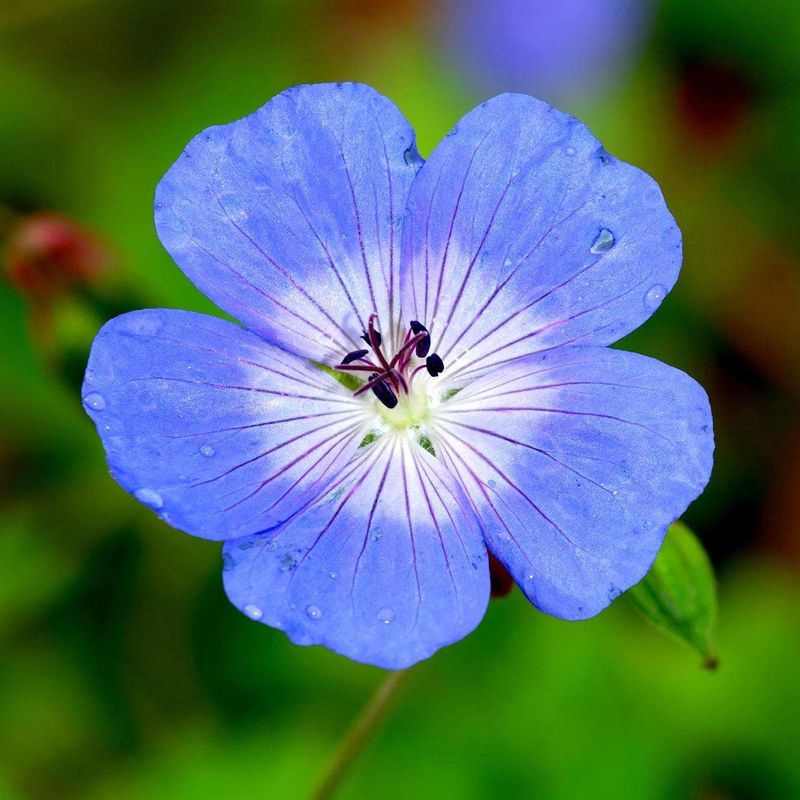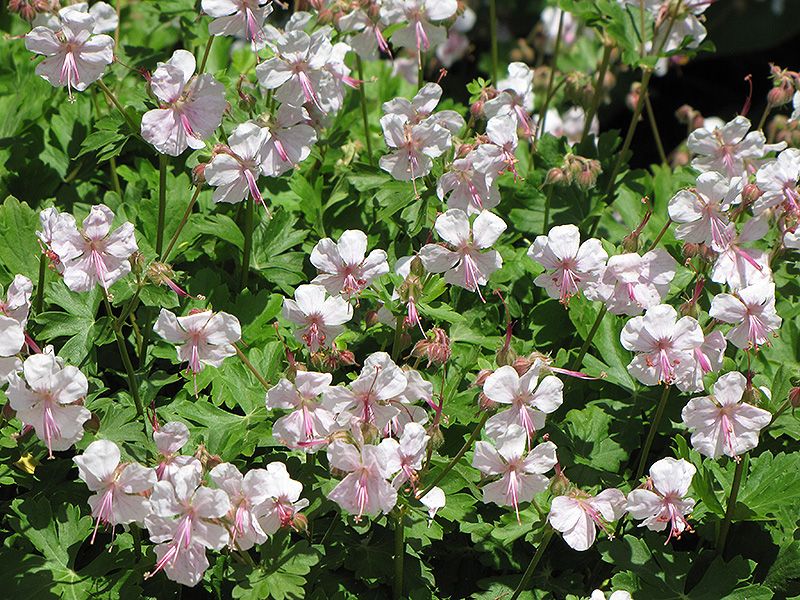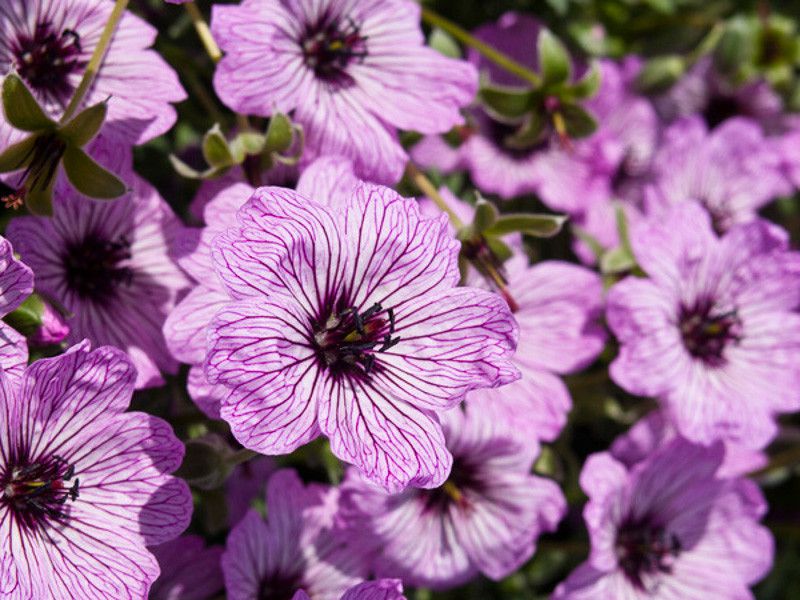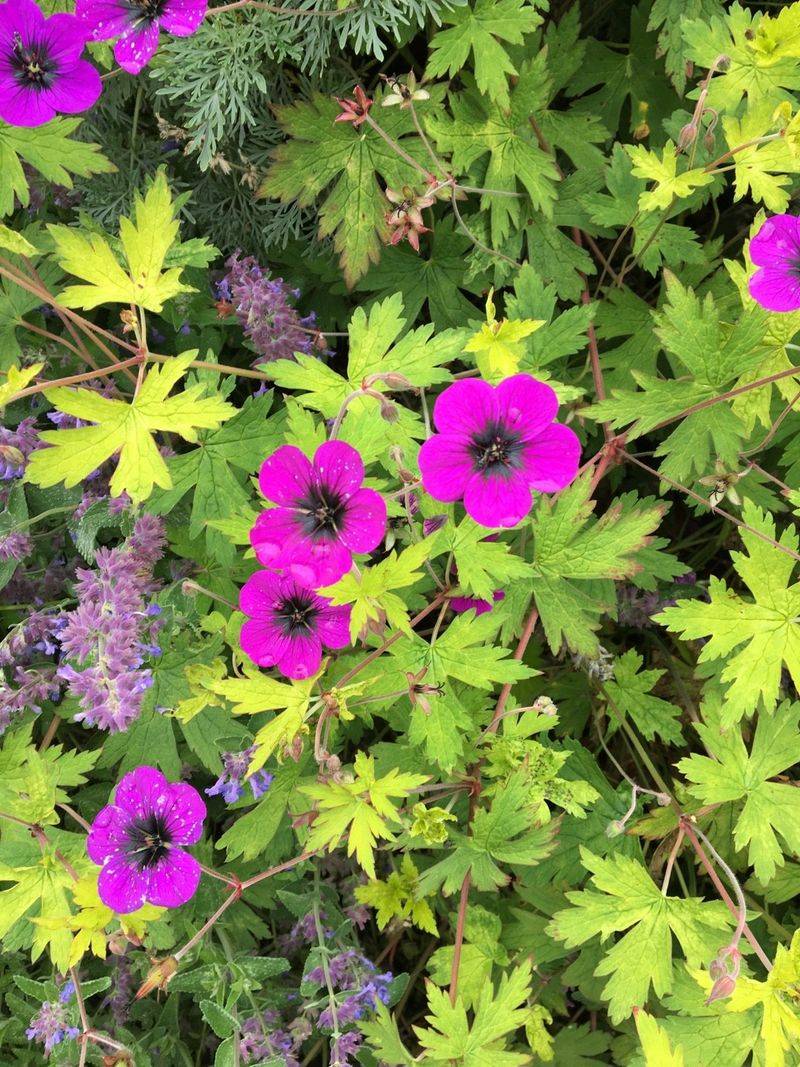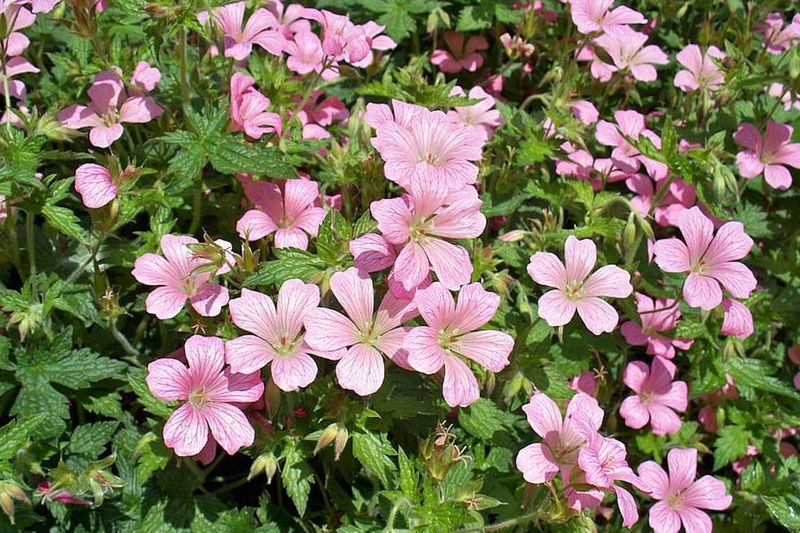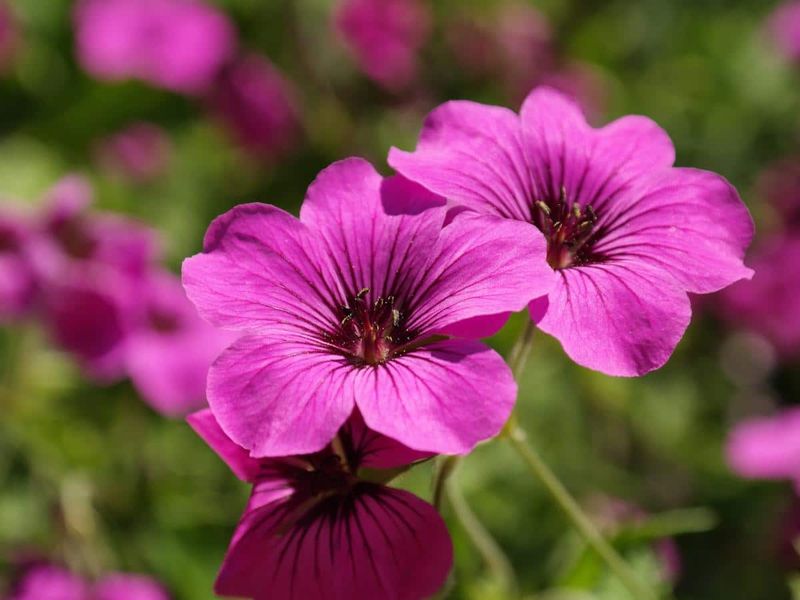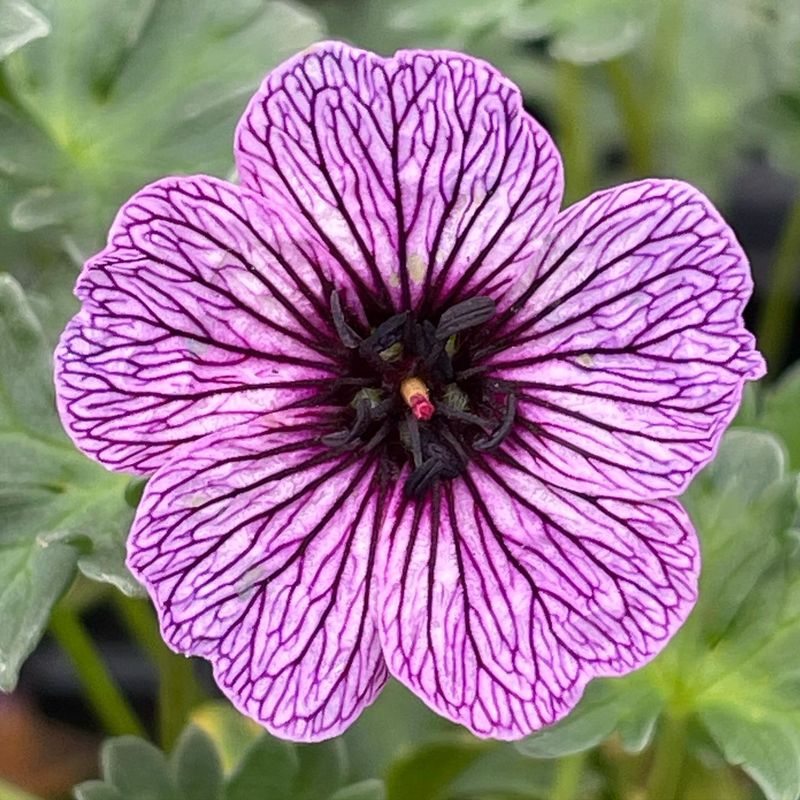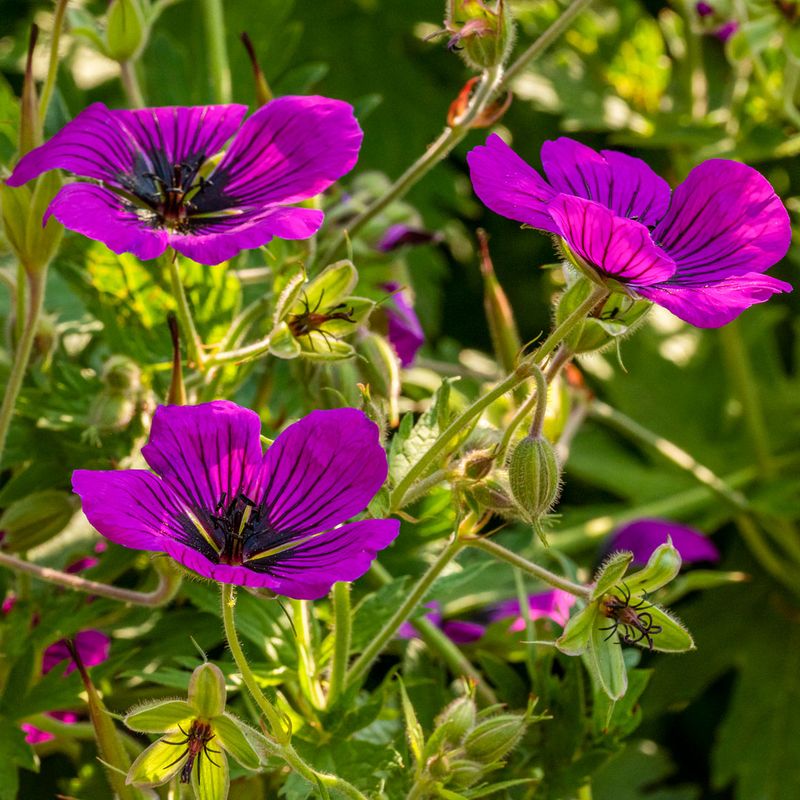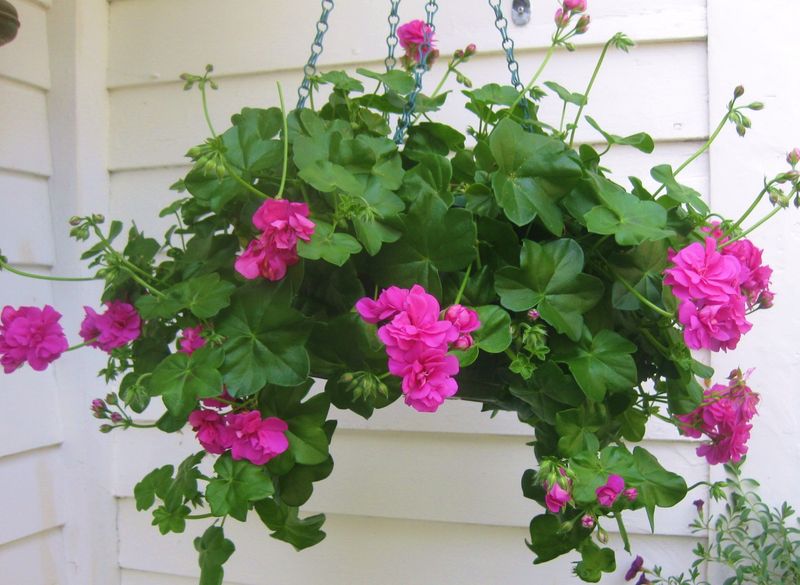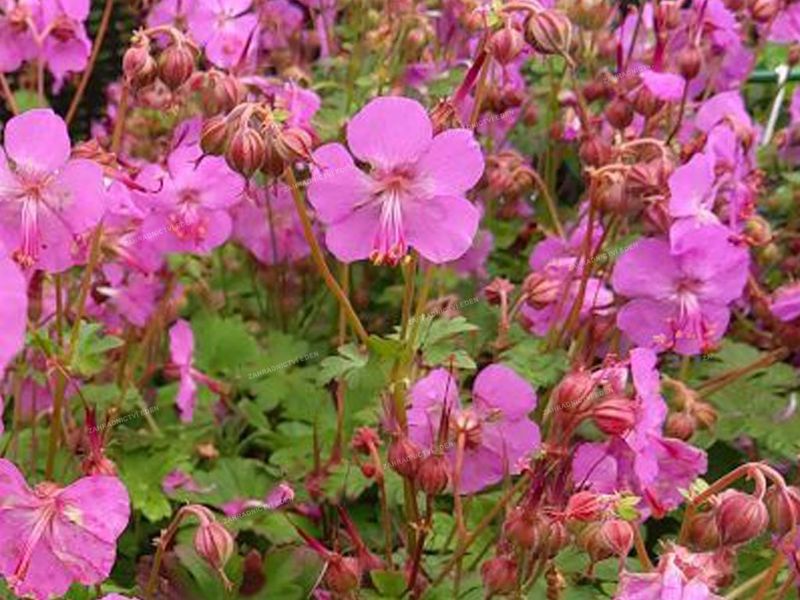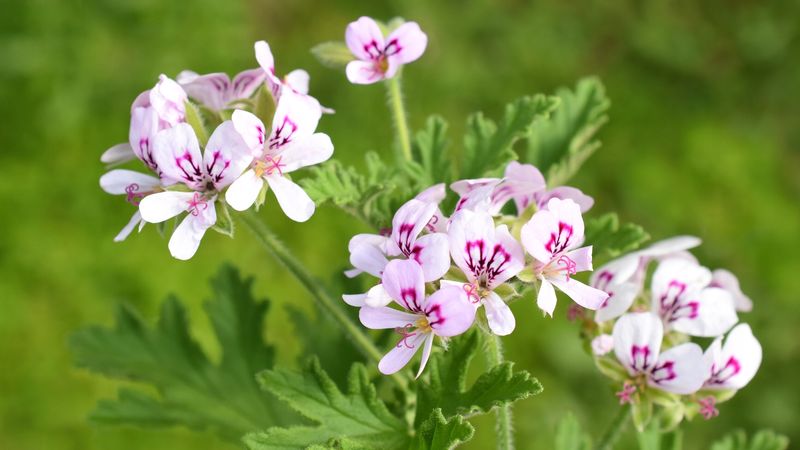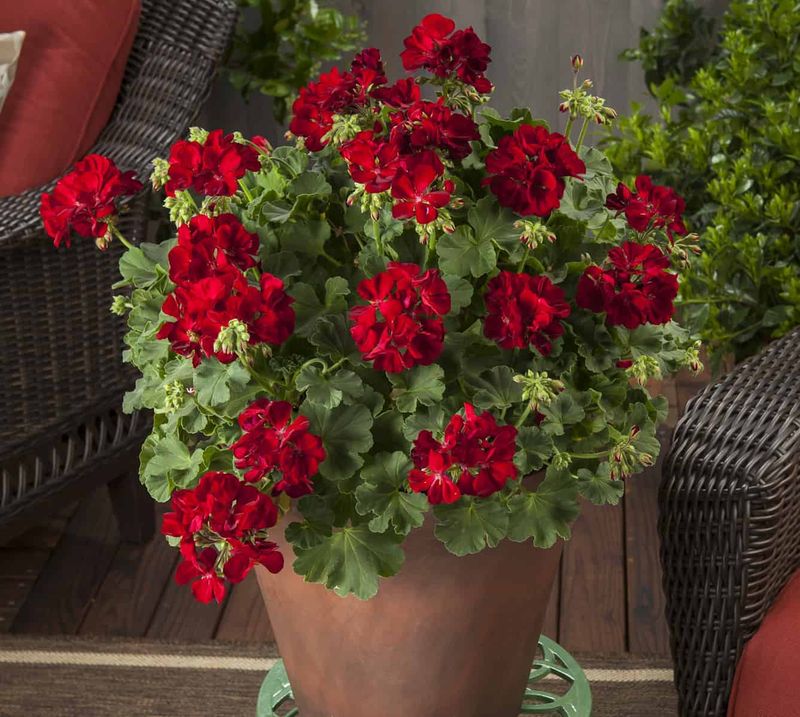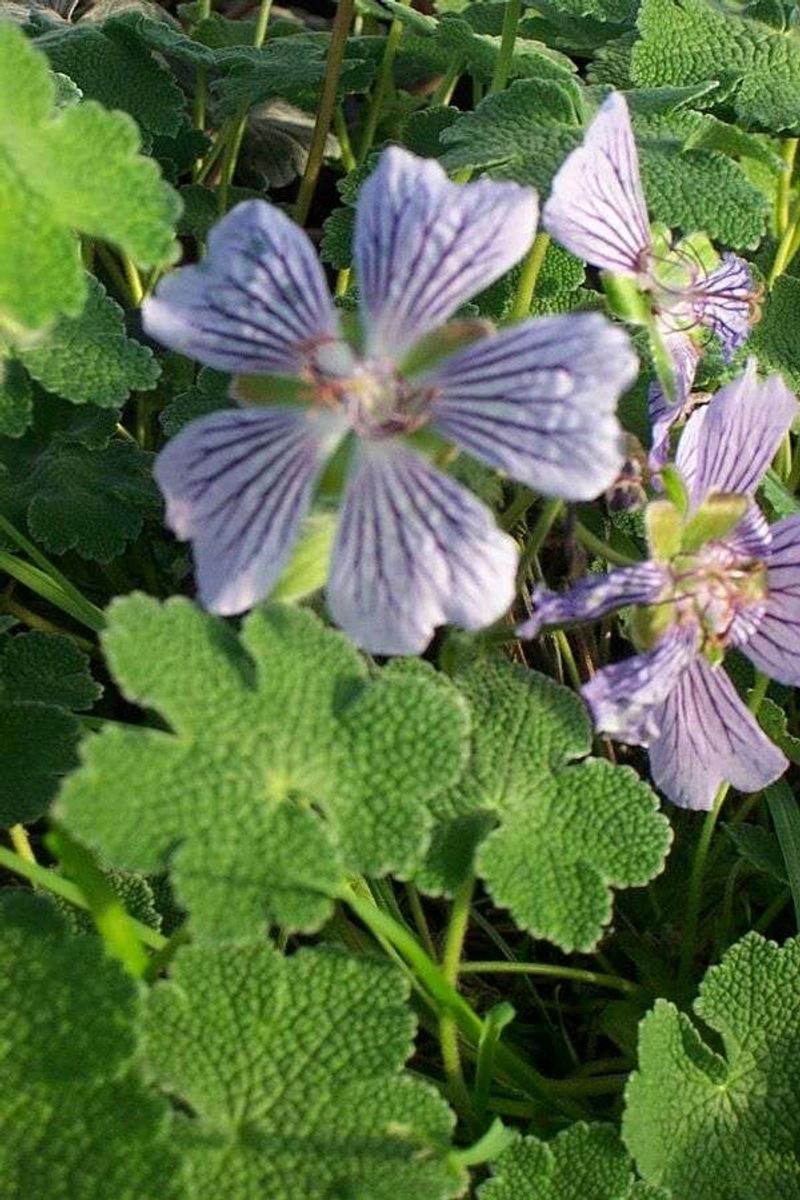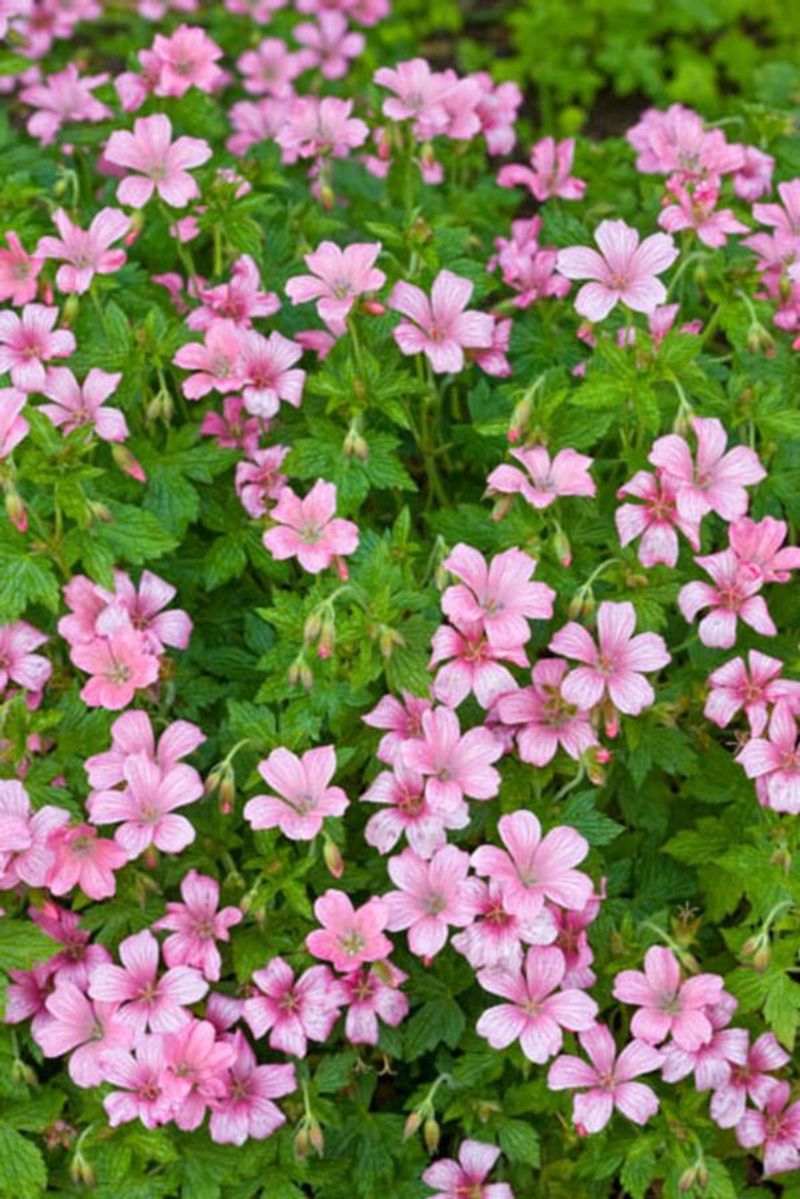Geraniums have a way of showing up and shining, no matter where you plant them. They’re one of those flowers that just quietly do their job—adding dependable color without demanding much in return. I’ve grown them in pots, borders, and even in awkward shady corners, and they always pull through.
What I love most is their variety—there’s truly a geranium for every spot in the garden. Some trail beautifully over hanging baskets, while others make great ground covers or add soft height in a sunny bed. You don’t need to be an expert to grow them either—they’re as beginner-friendly as it gets.
Whether you’re after bright pops of pink, deep magentas, or soft lavenders, there’s a geranium out there for you. And once you’ve planted a few, don’t be surprised if they become a go-to favorite for years to come.
1. Rozanne Geranium
Rozanne might just be the garden workhorse you’ve been searching for. This award-winning perennial blooms from early summer until frost, requiring minimal maintenance beyond occasional deadheading.
The large violet-blue flowers with white centers stand out beautifully against the deeply cut green foliage that takes on reddish tints in fall. It spreads to about 2 feet but isn’t invasive.
I planted Rozanne along my garden path three years ago, and it’s still the first plant visitors comment on. Even after a downpour, the flowers bounce back quickly while other plants stay flattened.
2. Bloody Cranesbill
The name might sound dramatic, but Geranium sanguineum earned it from its stunning crimson-magenta flowers and red-tinged autumn foliage. This low-growing variety forms neat mounds about 12 inches tall and spreads gradually without becoming a garden bully.
What makes this geranium special is its drought tolerance once established. The finely cut leaves create an attractive texture even when the plant isn’t flowering, and deer typically leave it alone.
My mother grew these along her front walkway for years. When I moved to my first house, she divided her plants and gave me some—now they’re thriving in my garden too, connecting our spaces across miles.
3. Johnson’s Blue
A classic that’s stood the test of time, Johnson’s Blue produces cup-shaped, sky-blue flowers that seem to float above finely dissected foliage. It reaches about 18 inches tall and creates a loose, slightly sprawling habit that softens garden edges beautifully.
Unlike some newer hybrids, this geranium has a distinct blooming period in early summer rather than continuous flowering. The trade-off is its remarkable hardiness—it survives in zones 4-8 without special winter protection.
Last year, I paired it with coral-colored roses, and the color contrast was so striking that several neighbors asked for cuttings. The combination of its blue flowers against the coral roses created a garden vignette I’m definitely repeating.
4. Biokovo Cranesbill
Subtlety is Biokovo’s strength. The delicate white flowers with pink centers might seem understated at first glance, but en masse, they create a cloud-like effect that brightens shady spots without looking flashy or demanding attention.
The semi-evergreen foliage turns brilliant reddish-orange in fall, extending this plant’s garden interest well beyond flowering season. It forms a dense mat that effectively suppresses weeds while staying a manageable 10-12 inches tall.
When my garden flooded during an unusually wet spring, most plants suffered—except Biokovo. It not only survived but thrived afterward, convincing me that sometimes the quieter plants are actually the toughest performers.
5. Ballerina Geranium
Ballerina geraniums dance in the slightest breeze with their unusually shaped flowers. The petals curve upward and backward, resembling the tutu of a ballet dancer, creating a distinctive appearance unlike typical flat-faced geraniums.
These plants excel in containers where their unique flower form can be appreciated up close. They bloom continuously from spring through fall if deadheaded regularly, and their compact growth (about 12-15 inches) makes them perfect for small spaces.
I keep one in a pot by my kitchen window. During morning coffee, I’ve noticed how the flowers seem to open differently each day—sometimes more curled, sometimes more relaxed—as if responding to the temperature and humidity.
6. Ann Folkard Geranium
This one makes a statement with its chartreuse-yellow young foliage that gradually darkens to green. The contrast between this distinctive foliage and the magenta-purple flowers with black centers creates a color combination that’s both unusual and eye-catching.
This geranium has a sprawling, almost scrambling growth habit, reaching up to 2 feet tall but spreading much wider. It weaves itself beautifully through neighboring plants, connecting different areas of the garden.
Despite trying several times, I couldn’t get Ann Folkard to grow in my clay soil until I added generous amounts of compost and grit for drainage. The effort was worth it—now it’s the backbone of my perennial border, threading magenta flowers through everything from June to October.
7. Mavis Simpson
Mavis Simpson creates carpets of soft pink flowers that seem to glow at dusk. This ground-covering geranium stays low, only reaching about 6 inches in height while spreading up to 2 feet wide, making it perfect for edging pathways or cascading over walls.
The silver-green foliage remains attractive even when not in bloom and turns reddish in autumn. One of its best features is its tolerance for poor, dry soil once established—it actually performs better with a bit of neglect.
When my neighborhood experienced water restrictions last summer, Mavis Simpson sailed through without additional irrigation. The plants in my front border maintained their neat appearance while other ground covers withered, earning this tough little plant a permanent place in my drought-resistant garden areas.
8. Patricia Geranium
Patricia commands attention with its large, cup-shaped magenta flowers marked with black centers and veining. Standing tall at 2-3 feet, it makes an excellent middle-of-border plant that provides height without requiring staking.
The deeply cut foliage creates nice texture even when the plant isn’t flowering. Patricia blooms heavily in early summer, takes a short break, then produces another flush of flowers in late summer if trimmed back lightly after the first bloom.
My garden club friends always ask about this geranium during tours. I’ve started calling it my “conversation plant” since it reliably breaks the ice when gardeners visit. Something about those rich magenta blooms against the dark centers just pulls people in for a closer look.
9. Cinereum Ballerina
Don’t let its delicate appearance fool you—Geranium cinereum ‘Ballerina’ is surprisingly tough despite its petite size. Growing just 6 inches tall, it forms tight mounds of silvery-gray foliage that set off the pale pink flowers with deep purple veining.
This little gem thrives in rock gardens, between stepping stones, or at the front of borders. The blooms appear in waves from late spring through summer, with each flower looking like it was hand-painted with its intricate veining pattern.
After dividing a friend’s plant three years ago, I tucked a small section into a difficult spot between two large rocks where nothing else would grow. It not only survived but has flourished there, proving that sometimes the smallest plants have the biggest impact.
10. Psilostemon
Looking for drama? Geranium psilostemon reaches an impressive 4 feet tall and almost as wide when happy. The magenta flowers with black centers appear in abundance throughout summer, creating a colorful cloud in the garden.
The deeply cut leaves take on spectacular orange and red tints in fall, extending this plant’s season of interest. It self-seeds moderately in ideal conditions, though seedlings are easy to identify and remove if unwanted.
I planted just one specimen five years ago, and it’s now the anchor of my perennial border. During a particularly harsh winter, it died back completely, and I thought I’d lost it—only to have it return from the roots even stronger the following spring. That kind of resilience makes it a keeper in my book.
11. Ivy-Leaved Geranium
Cascading stems covered with glossy, ivy-shaped leaves make this geranium perfect for hanging baskets and window boxes. The flowers come in shades from white to pink to deep red, often with interesting markings on the petals.
Unlike many geraniums, these prefer their soil to dry slightly between waterings and thrive in the heat of summer. Their trailing habit can create impressive 3-foot cascades by mid-season when properly cared for.
My grandmother always had these spilling from her balcony planters in Italy. When I hang mine each spring, the familiar scent of the leaves when brushed against brings back memories of summer visits to her apartment, where geraniums framed every window view.
12. Karmina Geranium
Karmina’s carmine-pink flowers create pools of color that last from early summer into fall. The semi-evergreen foliage forms neat mounds about 8 inches tall that spread slowly to create effective ground cover without becoming invasive.
This variety handles heat better than many other geraniums and maintains good foliage even during flowering periods. In autumn, the leaves turn brilliant red-orange, creating a second season of interest after the flowers fade.
The corner of my garden that gets reflected heat from a brick wall would kill most perennials, but Karmina has thrived there for years. I’ve come to appreciate how some plants seem to find their perfect spot despite what garden books might suggest about ideal conditions.
13. Scented Geraniums
Touch the leaves of scented geraniums and discover fragrances ranging from rose to lemon, mint, apple, and even chocolate. These varieties are grown primarily for their aromatic foliage rather than showy flowers, though they do produce small, delicate blooms.
The leaves vary widely in shape and texture—some deeply cut, others rounded or ruffled—adding interesting visual elements to container plantings. Many varieties make excellent additions to herb gardens, with leaves that can be used in teas, potpourri, or cooking.
I keep rose-scented geranium by my patio seating area. Guests often brush against it accidentally, then pause with surprise at the unexpected fragrance. It’s become a natural conversation starter during summer gatherings—much more interesting than talking about the weather!
14. Calliope Dark Red
This one combines the best traits of zonal and ivy geraniums into one powerhouse plant. The deep, velvety red blooms appear in abundant clusters that stand up well to summer rains without shattering or fading.
The semi-trailing habit makes this variety versatile for both containers and garden beds. It grows to about 14-16 inches tall with a spread of up to 20 inches, filling spaces quickly but staying within bounds.
After trying countless red geranium varieties over the years, this one finally gave me the exact shade of red I wanted for my front porch planters. The dark green leaves with subtle zonation provide the perfect backdrop for those rich blooms that keep coming until the first hard frost.
15. Renardii
Geranium renardii stands out for its uniquely textured foliage—sage-green leaves with deep veining that creates a quilted, almost corrugated appearance. The white or pale lavender flowers with purple veining hover above this distinctive foliage on short stems.
This smaller geranium (about 12 inches tall) performs beautifully in rock gardens or the front of borders. It handles drought well once established and attracts butterflies while deterring deer with its aromatic foliage.
During a garden redesign, I almost removed mine to make space for showier plants. Thankfully, I reconsidered after noticing how its textured leaves caught morning dew in an almost magical way, with tiny droplets outlining each leaf vein like natural embroidery.
16. Wargrave Pink
Wargrave Pink creates waves of salmon-pink flowers that brighten partially shaded areas where many geraniums wouldn’t thrive. This adaptable plant grows about 18 inches tall and spreads to form generous clumps that suppress weeds effectively.
The five-petaled flowers appear in loose clusters above the rounded, lobed leaves from late spring through summer. Unlike some geraniums that need regular division, Wargrave Pink maintains its vigor for many years without becoming overcrowded.
I inherited this plant when we bought our house—it was growing in a forgotten corner under a maple tree. Not knowing what it was, I almost pulled it out, but decided to wait and see what would happen. That patience rewarded me with a beautiful display that’s now one of my garden’s most reliable performers.

